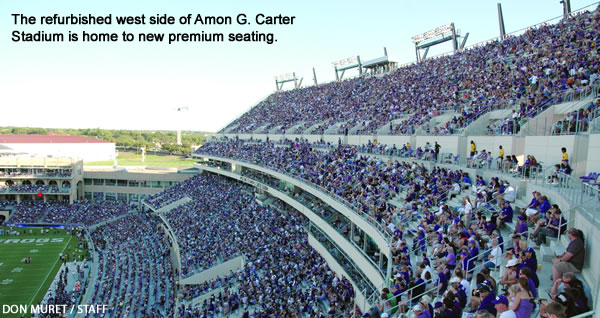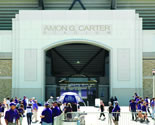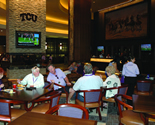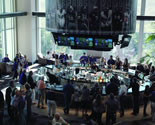
Take a peek inside the Founders Club at Amon G. Carter Stadium to get the big picture of Texas Christian University’s unique funding model for facility renovation.
The stately club, one of the most luxurious in college football, is reserved for the group of six donors who all committed $15 million over the next five years to help fund construction. Their total contributions of $90 million are paying for the majority of the $164 million project.
In return, TCU built an entire suite level for them at midfield, 21 rows from the field on the stadium’s west side. The 6,400-square-foot lounge supporting the suites has a fireplace and a large replica of Frederic Remington’s “A Dash for the Timber” behind the main bar.
The founders had the freedom to select the finishes and decor of their own suites with 24 fixed seats and 22 bar stools. A cowhide-covered foot rest, the centerpiece of one unit, speaks to both a level of comfort and the city’s western heritage. After all, it’s their home on football Saturdays for the next 30 years, per their deals.
“There is nothing nicer in America,” said TCU Athletic Director Chris Del Conte. “This is their living room, their space.”
The funding model arose after TCU Chancellor Victor Boschini Jr. issued a mandate for the 9,500-student private school to fund the renovation without being responsible for the debt tied to selling bonds.
Colleges typically pay off those bonds with contractually obligated revenue generated from the sale of premium seats and private donations from season-ticket holders.
The TCU administration did not want financing for stadium construction to affect funding for future expansion on the campus, so officials made a budgetary decision and relied on donors’ commitments to pay off a five-year line of credit for construction, Del Conte said.
That model may not work many other places, but in North Texas, where oil money flows toward football like the Trinity River flows through Fort Worth, TCU raised $164 million without having to bond any debt.
Additional gifts of $1 million to $5 million to buy the 19 new Champions Suites, all 10-year deals, helped the school reach its total number.
“What a smart decision it was because we hit it right,” Del Conte said. “It’s unique and I’m really proud. Coming off the greatest economic downturn in modern times, we built the stadium debt-free. It speaks volumes of the community.”
By reaching that benchmark, the $25 to $3,000 annual fees tied to ticket prices for 12,500 seats in the stadium, including 2,400 new club seats, go directly to the school’s scholarship program instead of being used to pay construction debt. The total is $11 million a year, said Jeremiah Donati, director of TCU’s Frog Club, which administers the scholarship seating program.
Overall, the renovation resurrects the art deco design theme consistent with the architecture in downtown Fort Worth in 1930, the year the stadium opened. During its initial research on campus, officials from project designer HKS found the original drawings for the stadium, which were full of art deco elements, said Jerry Fawcett, the firm’s associate principal and senior vice president. But early in the Great Depression, the school could not afford to incorporate all the design details and they were scrapped.
“It was supposed to be a much more upscale building,” Fawcett said. “It was stark and bare, not unlike a lot of stadiums built in that era. We were able to connect with their history and build to some degree what the intentions were always meant to be. We were very fortunate in that regard.”
The stadium redesign produced such a strong emotional connection between TCU alumni and supporters and city leaders that Fawcett believes it helped boost the school’s effort to raise money for the project. “I don’t think it hurt,” Donati said.
The retro design also fit with TCU’s goal to create the “Camden Yards of college football.” The catch phrase came from Danny Morrison, TCU’s former athletic director, who left the school in September 2009 to become president of the Carolina Panthers.
TCU
Amon G. Carter Stadium
Built: 1930
Project cost: $164 million
Renovation designer: HKS
Last major renovation: 2008
What’s new: In addition to six Founders
Level suites, 19 Champions suites and
2,400 club seats (which joined six existing
suites and 250 club seats), HKS designed
a renovation with wider concourses and
modern concession stands and restrooms
without increasing the stadium’s
overall footprint. HKS could not expand
east and encroach upon academic space
or Frog Alley, the school’s pregame tailgate
zone adjacent to the building.
As a result, HKS’ Jerry Fawcett said,
“It became a design driver for us to really
squeeze this thing down and still give
people comfortable seating depths and
keep [expansion] on the west side.”
The project reduced seating to about
45,000, down from 47,000. “There is a plan
to go to 50,000 seats if they need to on the
east side with another deck,” Fawcett said.

Premium seat details: Founders
Level suites (capacity up to 50) $15 million,
30-year term; tickets, food and beverage,
alcohol included; sold out. Champions
suites (capacity up to 24) $1 million to $5
million, 10-year term; sold out. Club seats
$1,000-$3,000 annually ($500 for season
tickets and food and beverage, remainder
as gift to TCU Frog Club); sold out.
Financing: Privately
financed through
donor commitments
and gifts.
Morrison originally hired HKS in 2006 to develop a master plan for stadium upgrades. Two years later, TCU opened a new building in the south end zone with six suites and a club lounge, plus football operations facilities.
“Two donors came to Danny and said, ‘We want to do something for the team and the fans, and we want to do it right now,’” Fawcett said. “It was the first premium product TCU ever had and set the tone for everything else.”
In keeping with the art deco theme, concession signs were designed to look like old movie theater displays. Concourse ads have a faded look to make it appear they were painted on the walls from the old days, said T. Ross Bailey, TCU’s associate athletic director.
Pepsi went the extra mile and custom designed a special logo from the 1930s at TCU’s request. To complete the “distressed look,” Bailey said, project officials found a 3M product for a vinyl graphics that when treated with a heat gun sucks the colors into the brick.
For a stadium that prefers to look old, the building embraces new technology. Cisco’s StadiumVision gives TCU the ability to “wrap” ad panels around game broadcasts on the facility’s 268 high-definition televisions.
AT&T invested in wireless infrastructure to improve coverage for mobile devices. Verizon and Sprint will soon follow with their own systems, Bailey said.
Bypass Lane, a mobile concessions company whose investors include Texas pitching legend Nolan Ryan, has dedicated lanes at 14 concession stands. Fans can text their orders from smartphones and receive a return text for pickup.
The six Founders donors are recognized on concourse pillars and on busts in a plaza outside the stadium. “So many buildings you walk into, nobody ever knows the story for who they were named for or who put the money behind them,” Bailey said.










